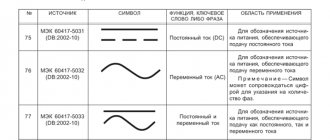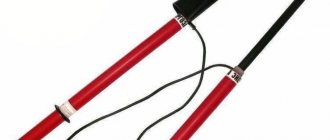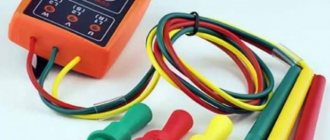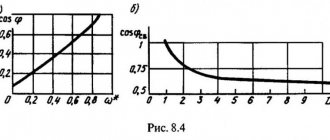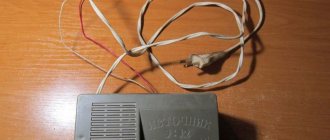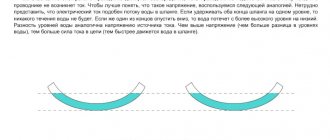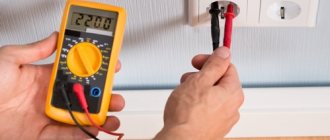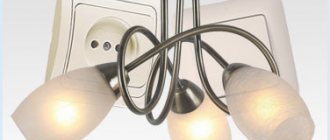Power meters and other parameters of network electricity are available in two models (almost identical in appearance and design). These are P06S-20 for 20 Amps and P06S-100 for 100 Amps. They look exactly the same, the only difference being that the transformer is connected to the more powerful version. The module dimensions are 85 x 47 mm (part recessed into the body), depth: 24 mm, the front panel measures 90 x 55 mm, and the display measures 55 x 30 mm. The price is approximately 1000 rubles.
The weaker version (20 A / 4.4 kW) is equipped with a measuring shunt with a resistance of 3 mOhm, and the stronger one (100 A / 22 kW) has an external current transformer with a ratio of 2000:1 (or 50 A / 25 mA). The transformer itself, according to the manufacturer, is adapted to measure current with an intensity not exceeding 150 A.
information about order
| Marketplace | Aliexpress |
| Cost at time of purchase | 15$ (539 rubles) |
| Delivery method | China Post Air Mail |
| From the moment of payment until the goods are shipped | 3.64 days |
| From the moment of departure until arrival in the city | 16.6 days |
| Product Name | Euro Plug Power Energy Meter Power Electricity Usage Monitor |
| Links | Product Seller |
The best household wattmeters
It is a compact device connected in parallel to the network. Most often, it combines a measuring unit and a socket in one housing. Equipped with a function for determining power consumption (minimum and maximum) per unit of time.
They reflect the value of the network voltage, the operating time of the electricity consumer, and the calculation of the cost of electricity for the working period of time.
ROBITON PM-1 – inexpensive
A device for monitoring the consumption of electricity from the household network by one consumer. It combines a plug, a socket, an electronic unit and a display screen for reading the results in one housing.
Allows you to calculate the power of a single load connected through the device. It will determine the amount of electricity consumed over a certain period of time and calculate the cost of the energy consumed.
Pros:
- Compact, simple, inexpensive.
- Can work with all household appliances.
- Determines the amount of electricity consumed by the heater.
Minuses:
- The reset mechanism is poorly thought out.
- Works only in warm conditions.
Recommendations: 10 best time relays
12 best hidden wiring detectors
14 best electricity meters
HiDANCE 3680W AC Power Meter – digital instrument
Compact consumer electronic device with advanced functions. Allows you to determine the magnitude of the AC voltage and current strength. Calculates power consumption and power factor.
There is a built-in option for calculating the cost of consumed electricity. The device is convenient for testing household appliances, electronic devices and electric heaters of all types to calculate economic efficiency.
Pros:
- Nice, neatly assembled digital device.
- Measurement accuracy, visual display of results.
- Several modes.
Minuses:
- You have to re-enter the price after resetting the results.
- The pins of the plug are not soldered, but welded.
Espada TSL 1500WB – optimal for home
An easy-to-learn and use electronic wattmeter for testing household appliances based on the level of electricity consumed. Very convenient for checking energy consumption when choosing a heater. The device will quickly show the actual power level, costs and cost of electricity.
Helps calculate thermal efficiency and costs during the thermal season. It is possible to enter data with a two-tariff meter. It will signal an abnormal mode or excess current or power.
Pros:
- Good accuracy and measurement speed.
- Display backlight, large numbers.
- Calculation of the cost of electricity.
Minuses:
- The backlight is not constant.
- Difficulty changing the power source.
MEGEON 71016 – with liquid crystal display
A portable digital device for recording consumed electricity by one consumer. The tool is equipped with a liquid crystal display with LED backlighting for operation in the dark or in low light conditions.
The calculation of indicators is carried out in a continuous mode, throughout the operation of the electricity consumer. An additional option is to determine the volume of carbon dioxide emissions, which is important for enclosed spaces.
Pros:
- Dimensions, functionality, cost.
- Monitors carbon dioxide emissions.
- LCD backlight.
Minuses:
- Price, ordering in China is cheaper.
- More likely for the workshop, for home use - for pampering.
Brennenstuhl PM 231 – high quality
Household appliance with a stylish body design (Primera-Line). Equipped with a two-tariff meter - day-night function. Measures network voltage, current, frequency.
Calculates power consumption. Calculates the amount of electricity consumed. Record the time in hours and minutes. It has increased safety - child protection is provided.
Pros:
- Excellent workmanship, precision.
- Stylish design, trouble-free operation.
- Shows real power, not declared.
Minuses:
- The font on the screen is too small.
Characteristics
| Input/output voltage | 230 Volt / 50 Hertz |
| Operating current | No more than 16 A |
| Measured voltage range | 190-270 V (accuracy 1 V) |
| Measuring current range | 0.001-19.999 A (accuracy 0.005 A) |
| Range of measured network frequency | 46-65 Hertz |
| Measuring power range | 0.5-3680W (0.5W accuracy) |
| Measurement error (V, A, W, kW*h) | plus/minus 3% |
| Display | LCD 2.5" |
| Dimensions (H, W, D) | 136x64x78 mm (depth including fork) |
Connection diagram P06S-100 and P06S-20
According to the diagram, the 220 V network input is connected to pins 3 and 4, and the output, that is, the load, is connected to pins 1 and 4.
Useful: Infrared rangefinder GP2Y0A02YK0F
Connecting both modules is very simple - they are equipped with a durable screw connection, the two terminals of which (labeled L and N) are used to connect the power supply. In the 20 A version, the energy receiver is connected between the L terminal and the “1” terminal (shunt on the N wire). In the case of a version with a transformer (connected to terminals “1” and “2”), the direction of installation of the transformer on the cable is important - there is an arrow on it that should point in the “zero” direction (L -> N).
The button, which is a microswitch protruding through a hole in the housing, is a bit primitive. Another problem is the lack of a CE mark, because without this mark the product cannot be admitted to trade in the EU. It is difficult to say whether this applies to this specimen, but the 20 A version has a clearly worse display - it has very small viewing angles, and when the backlight is turned on, it becomes almost illegible. In the P06S-100 version, the display has excellent readability, both without backlight and with backlight:
The device does not have certificates, and the manufacturer in some models does not even indicate the accuracy of measurements. Here are the parameters:
- Display resolution: voltage: 1 V, power: 0.01 W (up to 100 W), current: 0.01 A (up to 10 A),
- Power factor: 0.01 (1%),
- Measured energy: 0.01 kW/h (up to 1000 W).
- Data update rate: 1 Hz
The values in parentheses are the limit of the lowest measurement range; higher values can be measured but with reduced resolution.
Packaging and appearance
The order arrived in a standard small package, inside there was bubble wrap, in which there was a cardboard box with a wattmeter (also packed in plastic film).
After unpacking, we have in front of us: the wattmeter itself and quite detailed operating instructions (in English). I ordered a wattmeter for European plugs (EU Plug), when choosing, you need to carefully check so as not to buy one for a different standard (otherwise you will have to buy additional adapters).
There are no identifying marks on the wattmeter itself. The box shows the model DEM1499.
The quality of the case and assembly are at a high level: the plastic is strong, there are no gaps or creaks, and there are no pungent odors. There are ventilation holes on the sides and top. The wattmeter practically does not heat up: after several hours of continuous operation, the temperature of the back cover is only 39 degrees. Display: monochrome LCD, 2.5" diagonal. The quality of the display corresponds to the price of the wattmeter. The lack of backlight is disappointing; it would have been very useful. In certain lighting and viewing angles, it can be difficult to see the numbers. What's nice is that there are grounding contacts, as well as protective barriers in the holes for the plug.
On the back we see a sticker with the power characteristics of the wattmeter, TUV and GS quality marks are also placed, supposedly the device has been tested for safety and everything is fine
The wattmeter already had 2 LR44/AG13 batteries installed (with protective paper, of course). They are needed to save settings (time, cost of kWh, etc.). However, when the batteries are installed, the display is always on. The contrast is lowered, but still, in my opinion, this is a flaw. They could make it auto-shutdown when inactive. It’s good at least that the battery pack is not bolted down, so if you want to completely de-energize the wattmeter, just remove the battery pack a couple of millimeters.
How to use
Today, digital wattmeters are the most popular, especially for domestic needs. They are more functional than analog devices and are easier to use, since ready-made results of wattmeter readings are displayed on the screen, which you configure for operation. Do the work like this:
- Connect the wattmeter to the outlet.
- Make sure the display shows zero and the screen is clear of the last reading.
- Connect the household appliance whose characteristics you want to measure to a wattmeter.
- In just a few minutes, the readings will appear on the screen.
- If you no longer need the information received, then click the reset button and destroy it.
The power indicator in an analog-type wattmeter is shown on an arc scale, graduated depending on the model. The moving arrow will stop opposite the power indicator corresponding to a certain section of the chain.
But before you start using a wattmeter, you need to familiarize yourself with the safety rules, this will make it possible to avoid electric shock. Since the devices operate with a voltage of 220V, the health hazard can be fatal. Before work:
- Check the wattmeter for damage to the case or plug; do not use it if there is any damage.
- Do not open the case yourself, entrust the work to specialists, this will make it possible to keep it intact and not pay for more expensive repairs.
- Do not use the device outdoors or in damp areas as this is dangerous.
- Do not allow water to enter; if the measurement is carried out near, for example, a washbasin, then do not approach within a distance of less than one meter.
As you can see, everything is simple here and you don’t have to undergo special training or worry about safety if you follow certain rules. Now let's figure out how to decrypt the received data.
Settings
The wattmeter has 4 buttons.
- OK - save settings / reset the value of the maximum measured power, current;
- VALUE H/+ - switching modes of measured parameters in the upper part of the display (current, voltage, power, etc.);
- DISPLAY M/- - switches the displayed readings in the middle part of the display (device operating time, total kWh, total cost, etc.);
- SET - enters the mode of changing time, cost of one kWh.
To set the cost of one kWh, you need to press the DISPLAY button until COST kWh is displayed, then hold the SET button for 5 seconds until a sound signal appears, and use the H/+ and M/- buttons to set the cost in rubles. Switching between digits is carried out with the SET button, the OK button completes the entry. I note that the euro sign is displayed; it cannot be changed to rubles, but this does not really matter. It is also possible to set a night tariff (cost and time when it starts to operate).
To reset the time counter, total kWh and cost, you need to press the VALUE button until the current value (A) appears, then press and hold OK until the signal appears (thanks to Yuri for the information).
Instructions for controlling the P06S wattmeter
Below are instructions for one control button:
- Press the button to turn the backlight on or off.
- Hold for 3 seconds to set the power alarm threshold. 2.1. Let's get to the power alarm setting (the factory default is set to 4.4 kW). 2.2. The 1st digit of the highest digit will begin to blink; pressing once will add one; hold the button for 2 seconds to move to the next digit (digit); the maximum value that can be set is 99.9 kW. 2.3. If you do not press the button for 5 seconds, you will exit the settings and save the current data.
- Hold the button for 5 seconds - the system will reset to default settings: the electricity meter will be cleared and the power alarm will be reset to the factory setting.
When the power alarm threshold is exceeded, the device starts flashing its backlight.
The power consumption of the meter is less than 1 W. The meter is equipped with one button with which we can turn the backlight on or off, set an overload alarm and reset the energy meter. The function is selected by changing the time the button is held. It is worth noting that the device retains its indication even after the power is turned off.
In the box, in addition to the meter and transformer (for the powerful model), there is a modest instruction manual printed on one sheet. On the one hand there is an English version, on the other there is a Chinese version.
Both meters are based on the same PCB, differing only in the resistor configuration. In the 20 A version there are two 6 mOhm resistors - they are connected in parallel in size 2512, forming a measuring shunt, and in the 100 A version (equipped with a transformer) a 1 Ohm resistor of size 0603.
At a maximum current of 20 A, there is a 60 mV drop across the shunt, which would give 0.6 W per resistor (resistors of this size can dissipate 1 W).
In the transformer version, at a maximum current of 100 A, a current of 50 mA will flow through the shunt, which will correspond to a voltage drop of 50 mV and a power of 2.5 mW, which a resistor size 0603 should easily cope with.
The basis of the circuit is a specialized microcontroller HT5019. This is a chip for building single-phase power meters based on the M0 core with 128 KB flash memory. The second integrated circuit present on the board is the LCD driver (32x4) VK1621B. A transformerless power supply consisting of a capacitor and resistor is responsible for powering the electronics. There is no decent protection for this power supply (other than a resistor).
Functionality
The indications at the top of the display may be as follows:
- mains voltage (Volts);
- current current consumption (Ampere);
- maximum recorded current (Ampere);
- current power consumption (Watt);
- maximum recorded power (Watt);
- overload current (Ampere);
- network current frequency (Hertz);
- power factor (cos φ).
Data is updated approximately every one and a half seconds. In the middle part you can see:
- operating time of the connected device;
- current time;
- the total number of “running” kilowatt-hours (kW*h);
- cost of 1 kilowatt per hour (set);
- total cost during operation.
Update once per second. The lower part of the display is reserved for statistics of “eaten” kWh for 7 days. The rightmost column is labeled "-1", which is yesterday's reading. Each strip can indicate 1, 2, 5, 10 or 15 kWh, and is selected automatically. The statistics function will be useful for those who plan to constantly use the wattmeter, and not for single measurements.
Measuring unit based on P06S-100
And here is a simple homemade measuring unit based on the P06S module. Some time ago we ordered the P06S-100 measuring module. It sat in the nightstand for a while until I wanted to check how much current and power the 3D printer consumes. And at the same time other consumer electronics.
Everything was assembled in a housing made of plastic ventilation duct. Parts used:
- module P06S-100,
- ventilation duct,
- automatic switch Legrand B6,
- 2 connectors with grounding,
- 2 illuminated switches,
- 2 connection lines,
- computer socket with coils and capacitors,
- fuse.
Internal connections were made with a 2.5 mm2 cable, which was left over after installing the electrical network.
At the end, sockets were made and a 6 A automatic fuse was connected. At prices in a local electrical goods store, it cost 2,000 rubles.
There is also a socket with a light bulb for checking devices. The device works correctly, regardless of how it is connected to zero and phase: L and N.
The network noise voltage will accumulate across the measuring resistor and will always have the same value for the measuring circuit, regardless of whether it is on the L or N bus.
To summarize, both wattmeters work correctly and are suitable for long-term monitoring of a device's power consumption. However, keep in mind that the device has not been tested by any reputable laboratory and has virtually no security features. Yes, there is an isolation slot between terminals L and N, and a VDR 10D471K varistor is connected in parallel to these terminals. However, there is no fuse that will blow once the varistor is activated.
But despite these shortcomings, we have been successfully using such a meter, built into the electrical panel, for 4 years now to control the energy consumption of external consumers in our personal plot. The switchgear is located on the wall of the building, and the multifunctional digital wattmeter has survived the second winter and works flawlessly. You just have to remember that this is not an exact laboratory instrument and its readings should be considered as estimates.
Power measurement
I do not have special certified equipment to check the measurement accuracy of this Chinese wattmeter, so I will compare the power of the devices with that declared by the manufacturer.
Energy saving lamp 11 W
Surprisingly correct: 11 W, the lamp says 11 W.
Energy saving lamp 13 W
Everything is accurate, it shows 13 W, the lamp indicates 13 W.
Incandescent lamp 60 W
Due to the fact that the voltage in the network was not 220 Volts, but slightly higher, the power of the incandescent lamp accordingly differs from the nominal one.
Microwave printing 1150 W
Set the maximum power. The wattmeter showed from 1043.5 to 1058.5 W.
I will provide a table with the results of measuring the power of other devices.
| Device | Measured power (average) | Stated |
| Smartphone charger 2A | 11 W | ? |
| 2.4 A Tablet Charger | 13.5 W | ? |
| CRT TV 29′ | 2.5 W in stand-by mode 74 W during operation | ? |
| System unit (I5-3570K, GTX670, HDD+SSD)+monitor | 94 W (no load) 298 W (load) 5 W (sleep) | ? |
| Laser printer | Off - 0.5 W In standby mode - 3 W When heating the stove - 625 W When printing - 248 W | Standby - 2.8 W Printing - up to 270 W |
| LCD monitor 24′ | Standby mode - 0.5 W Brightness 100% - 24.5 W Brightness 50% - 18 W Brightness 10% - 13 W | Standby - up to 0.2 W Operating - 23 W |
| Hairdryer noname | 580.5 W | ? |
| Fan heater | 1886 W | 2000 W |
| Vacuum cleaner | 1021.5 W | 1500 W |
| Split system | 868 W | 980 W |
| Washing machine INDESIT WI84X | Average - 200-400 W Maximum - 2042 W | Up to 1850 W |
The cost of one hour of operating my PC in normal mode (browser, media) costs about 34 kopecks. When loaded, the cost increases to 1 ruble. One hour of operation of a CRT TV costs 28 kopecks. To charge a tablet with a battery capacity of ~11000 mAh once - 21 kopecks. It only costs 7 kopecks to heat up lunch in the microwave. An hour of operation of a split system costs 3 rubles, one wash costs 2.6 rubles.
Modern smart wattmeters
Modern smart wattmeters installed in a socket include an electronic module that provides reliable communication with the home owner via the Internet. Control is carried out remotely via a mobile smartphone or other device. Due to this, the functionality of smart wattmeters has expanded significantly. With their help, it is possible to remotely turn off equipment operating in the house in the event of abnormal or emergency situations.
Such devices are widely used in research laboratories involved in improving the principles of energy saving.
As an example of a smart socket-wattmeter, we offer for consideration the TP-Link HS110 model, which is very popular among consumers. Her work is characterized as follows:
- control and reading of power consumption is possible from a distance;
- remote switching of household electricity consumers is provided;
- Remote monitoring of energy consumption allows the user to select the optimal heating operating mode, and will also help set the desired level of power consumption.
Despite all the advantages of smart plug-in energy meters, they also have certain disadvantages: the high cost of smart products and the dependence of their functionality on the reliability of the existing communication channel.
conclusions
It is clear that this wattmeter is not an accurate certified device, like most others for the same money, but it is enough for household needs: you can estimate the power of household electrical appliances, the cost of operation over a certain time, measure network parameters and much more.
pros
- The readings are similar to real ones, sufficient for household measurements
- High quality case
- Possibility to set two tariffs
Minuses
- The display is constantly on when batteries are inserted, there is no auto shutdown
- No display backlight
For those who want to return 7% of the cost of the goods on Aliexpress
For those who will buy on Aliexpress, I can offer to save money with a cashback service, for example, epn.bz, which I personally tested. You will receive 7% of the cost of the product, although there are subtleties: you need to follow a special link, do not use the discount from the Ali mobile application, etc. If you have any questions, write in the comments or via feedback.
Pros and cons of energy consumption meters
The advantages of electronic devices such as “electricity meter sockets” include:
- accessibility for any user;
- the ability to evaluate each household appliance in the house according to its energy intensity;
- ease of handling.
In addition, from the readings displayed on the indicator, the user receives a complete picture of the parameters of the operating electrical network.
Based on the data read from the electronic display, it is possible to estimate electricity costs for a fixed period of time.
The disadvantages of devices of this type include:
- there is a maximum load limit (no more than 3.6 kW);
- impossibility of using the adapter in unheated rooms.
Most samples of electrical appliances connected to the home network fit into the maximum power rating.
How to set the cost per kilowatt hour in a wattmeter
Using the FUNCTION button we get to the screen, where there is nothing except the top and bottom fields. Press and hold the COST button for about 3 seconds. Then press the FUNCTION button to select the digit (rubles, kopecks) and use the UP/DOWN buttons to set the desired numbers.
conclusions
The most unexpected thing was the measurement of computer consumption. It turned out that in a house with an abundance of equipment (refrigerator, microwave oven, electric kettle, several computers and gadgets), more than a third of electricity consumption comes from a gaming computer, which never turns off. If you actually play on this computer for several hours every day, then this consumption will exceed half of the total consumption.
Also, after measurements, it was decided to abandon the use of an electric kettle and optimize the loading of the washing machine, and not wash socks alone (which also saves water).
In summary, I strongly recommend purchasing and periodically checking your devices for consumption. You can buy one such device with your neighbors or for several families and give it for use. Although, I feel like the 700 rubles spent will cost me back in a month, and then it will only be a plus.
How to find out electricity consumption using a lamp as an example
The most common way is to take the rated power multiplied by the time of use and the kilowatt clock is ready. Then we multiply them by the price and the price is ready.
Let's take for example. Usually in Russian stores the real and equivalent power is written on such lamps. For calculations we need the real one. That is, 3, 5, 7, etc. watt. Let’s say that a lamp with a real power of 7 watts shines for 3 hours in the evening every day for 30 days.
- 7 watts * 3 hours per day = 21 watts per day = 0.021 kilowatts per day
- 0.021*30 = 0.63 kilowatts per month
Well, what if the lamp does not work for a full hour? Let's say we turn on a 100-watt lamp for literally half an hour a day (real 100 watts). Those. we know that the lamp consumes 100 watts per hour. Respectively:
- 100 watts / 60 min = 1.6 watts / min = 0.0016 kilowatts / min
- 0.0016 kilowatt/min * 30 min = 0.048 kilowatt per day
- 0.048 kilowatts *30 days = 1.44 kilowatts per month
useful to read on AleExpress Finger pulse oximeter from Aliexpress... and 17 comments
This is not a tricky way to calculate. And it is suitable for calculating the consumption of any simple devices that do not change consumption throughout use. But there are few such devices now.
How to calculate the electricity consumption of a computer
If in the case of a light bulb the approach described above is completely justified, then with complex devices this method of calculating electricity consumption is absolutely not suitable.
Most modern appliances used in everyday life are equipped with energy saving functions to one degree or another and the rated power is selected only at peak, and the corresponding simple formula for calculating energy consumption is not suitable for them.
Such devices include:
- TV
- computers
- tablets and phones while charging
- fridge
- washing machine
- even modern heaters and irons can turn off during use and release the accumulated heat without consuming electricity
To calculate the electricity consumption of such devices, simple and inexpensive devices are used : Wattmeters . The wattmeter is inserted into the socket, and the computer plug is inserted into the socket of the Wattmeter. And the wattmeter, at least, shows the current consumption in real time.
Slightly more complex wattmeters can calculate consumption per day, month and calculate the cost of electricity spent.
For example, the consumption of an average power computer (Core i5/7850/6 hard drives), measured using a wattmeter, in office mode was less than 70 watts. And during the game, the consumption jumped to 180 watts. Which, you see, is a colossal difference that can only be seen with a wattmeter. And, thanks to the wattmeter, I learned the easiest way to save money is to stop your child from playing ;).
You also need to understand that as some appliances wear out, they may use more electricity than when they were new. Therefore, it is extremely useful to be able to measure the real consumption of the device, and not count according to what is written on the plate.
